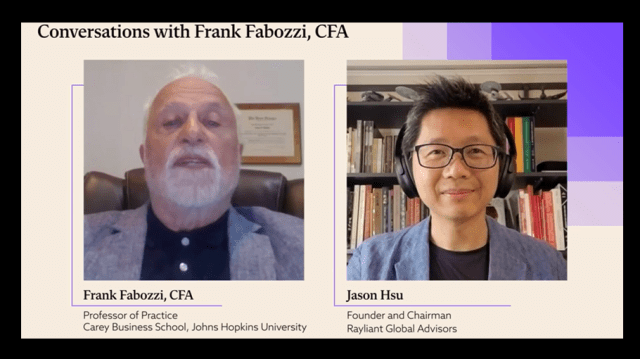I recently sat down with Jason Hsu, founder of Rayliant Global Advisors and chief economist of East West Bank, to discuss the evolution of factor investing, the challenges facing the asset management industry, and the opportunities offered by modern technologies and approaches.
This interview is part of the Conversations with Frank Fabozzi, CFA series, sponsored by the Research and Policy Center. The series aims to bring leading experts in finance and economics into dialogue to explore critical issues shaping the industry’s future. Hsu is a recognized leader in quantitative asset management and co-founder of Research Affiliates. You can register for my upcoming conversation with Lori Heinel, CFA, EVP and global chief investment officer at State Street Global Advisors here.
Hsu’s reflections in this session underscore the shifts in investment paradigms, the growing pressures on asset managers to differentiate themselves, and the critical role of governance, innovation, and long-term thinking in navigating an increasingly competitive and complex environment.

Expanding the Factor Universe
Hsu begins by tracing the origins and evolution of factor-based strategies. Initially rooted in academic finance, these strategies have become staples in institutional and retail investing. Traditional factors, such as value, momentum, and size, continue to play a significant role, but Hsu highlights a growing appetite for expanding the factor universe.
Today, asset managers are increasingly incorporating macroeconomic signals, such as interest rate changes or inflation dynamics, alongside behavioral factors driven by market psychology. This broadening of the factor toolkit reflects both a response to market commoditization and a recognition that traditional factors, while still valuable, cannot alone address the complexities of modern financial markets.

One of Hsu’s key points is the importance of grounding factor-based strategies in clear economic rationale. He warns against over-reliance on historical data or data-mining approaches that lack theoretical justification. While backtesting can yield impressive results, strategies derived without a solid understanding of their underlying drivers risk failing in real-world conditions.
Hsu argues that robust factor strategies should be built upon empirical evidence and an intuitive understanding of how and why certain relationships persist across different market environments. This combination ensures that factors remain relevant and effective even as market dynamics evolve.
The commoditization of basic factor strategies is a central theme of Hsu’s discussion. As quantitative tools and techniques have become more accessible, the barriers to implementing traditional factor models have diminished. This has led to declining fees and heightened competition among asset managers, pressuring firms to differentiate themselves through innovation.
Hsu notes that differentiation often entails exploring new or custom factors, but it also requires maintaining transparency and aligning with client expectations. Firms must balance pushing the boundaries of innovation and delivering strategies that investors can understand and trust.

Structural Challenges in Asset Management
Hsu also addresses the structural challenges within the asset management industry, particularly those related to governance and incentives. He critiques the pervasive short-termism that dominates many investment decisions, arguing that this mindset often misaligns with the long-term goals of institutional and retail investors.
The pressure to deliver quarterly results frequently leads to strategies prioritizing immediate performance over sustainable value creation. Hsu advocates for governance structures that reward long-term thinking and encourage asset managers to focus on delivering outcomes that align with their clients’ broader objectives.
The role of technology in reshaping asset management is another critical focus of the interview. Hsu acknowledges the transformative potential of machine learning and artificial intelligence in modern portfolio management. These technologies enable asset managers to uncover complex patterns, process vast datasets, and develop more sophisticated models.
Hsu cautions against the indiscriminate use of technology, highlighting the risks of overfitting and the lack of interpretability in many machine learning models. In finance, where decisions often have significant consequences, the inability to explain how a model arrived at its conclusions can undermine its practical value.
Hsu argues for a balanced approach to integrating machine learning (ML) with traditional financial and economic theory. Rather than replacing established methodologies, ML should complement them by enhancing the understanding of complex relationships and providing new insights. This integration ensures that models remain robust and interpretable, enabling portfolio managers to leverage the strengths of advanced analytics without sacrificing transparency or trust.
Rigorous, Data-Driven Approaches to ESG Needed
The increasing prominence of environmental, social, and governance (ESG) investing forms another key theme in my conversation with Hsu. He observes that demand for sustainable investment strategies has grown significantly, driven by both institutional mandates and shifting societal expectations.
However, incorporating ESG considerations into investment processes presents unique challenges, particularly in quantifying ESG impact and integrating it into traditional portfolio frameworks.
Hsu emphasizes the need for rigorous, data-driven approaches to ESG investing to ensure that it goes beyond superficial claims or “greenwashing.” By aligning ESG metrics with broader financial goals, asset managers can develop strategies that are both impactful and economically viable.
Diversity within investment teams is another area where Hsu sees significant opportunities for improvement. He argues that fostering intellectual diversity and encouraging collaboration are essential for success in the evolving asset management landscape.
Diverse teams bring varied perspectives and approaches to problem-solving, which can enhance creativity and adaptability. In an industry where market conditions and client demands constantly change, the ability to think critically and adapt quickly is invaluable.
One of the most compelling aspects of my conversation with Hsu is his discussion of the challenges and opportunities in implementing factor-based strategies in real-world market dynamics. He notes that value and momentum are not static but evolve as markets change. This evolution requires constant re-evaluation and adaptation of strategies to ensure their continued relevance. Hsu highlights the importance of stress-testing factor models under different scenarios to assess their robustness and potential vulnerabilities.
Customization is Key
Hsu also reflects on the growing role of customization in asset management. As clients demand more tailored solutions, firms must develop strategies that address specific needs and objectives. This customization often involves creating unique factor combinations or integrating non-traditional data sources, such as alternative datasets, to enhance predictive accuracy. By aligning strategies with client-specific goals, asset managers can deliver greater value and differentiate themselves in a competitive market.
The Future of Asset Management
The interview concludes with a forward-looking perspective on the future of asset management. Hsu envisions a continued shift toward greater reliance on technology, customization, and integration of non-traditional data sources. He stresses the importance of adaptability, both at the firm level and within individual teams, to navigate the complexities of modern markets. Hsu’s insights underscore the need for a holistic asset management approach that combines innovation, rigorous analysis, and a commitment to long-term value creation.






